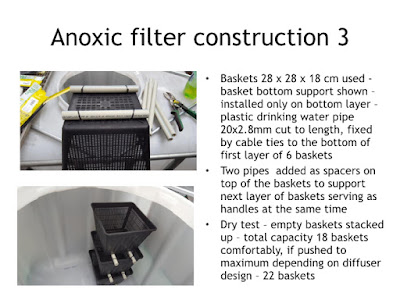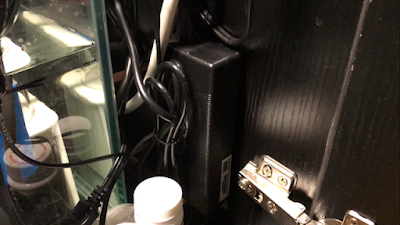Review of a Current
eFlux 1900-gph DC pump with flow control.
If there is
one thing I loathe about aquariums with sumps and overflows is the noise from
splashing water going into the weirs overflow and then the return water into the
sump via the pluming. I have written and made some YouTube videos on how to
remedy this problem by adding a reducer endcap at the end of the return 1” pipe
in the sump that equals that of the pumps output. Most pumps will never meet
the requirement of a 1” pipes fulfilment to make it a solid full suction pipe. However, once that problem is remedied
to one’s satisfaction then the next issue is the return pump that is the heart
of the system making noise and/or heating up the aquariums water.
After buying
the SCA 50 gallon Starfire Glass Aquarium complete package which comes with an Atman
PH2500 return pump, (650-gph with a 7.5’ head shut off using 45.5 watts of
power) is not quite the right pump for complete control over the restricted
water coming from the weir into the sump via a 1” return pipe. It works, but
because of the pumps short comings of a reduced amount of torque and only
pumping at a measly 275-gph due to head pressure it would falter in keeping the
weirs water level at a precise preset water mark. Note: If water in the weir drains too slow to the sump the
water will then rise in the weir until it begins to trickle down the emergency
standpipe and make noise. If it drains too fast, then the sumps return pipe
will start sucking in air with water and begin to make and unbearable noise in
the sump and weir too. Therefore, you need a pump that can overcome these hindrances
in keeping water levels steady in the weir and keeping the whole system quiet
when running.
It now was
time to get a more competent pump to do the job than the smaller Atman that
came with the setup could not do. In my aquariums, I like moving volumes of
water from point A to point B as fast as possible without hindering the
inhabitance daily routine. This way particulate matter gets into the mechanical
filter and out of the waterbody giving it a clean polished look. Velocity on
the other hand, may deceive the hobbyist into a false sense security that they
are moving lots of water when they have only restricted volume and turnover
rate of the aquariums pump. Because the SCA comes with Duckbill outlets as part
of the pluming, to stimulate velocity, a stronger pump will do the same plus
add the needed volume output to keep the system cleaner. Most aquarium turnover
rates should be between 5-10 ratio of the tanks volume and I prefer to keep
turnover at the higher mark. All pumps in this review can be use internally or
externally if needed.
Choice one on my short list was the
Eheim model 1262 hobby pump (898-gph, head 11.8’ to shut off and 80 watts of
power consumption priced at $ 179.99 USD.). Eheim is one of the better aquarium products out there in my
opinion for the hobbyist in as far as reliability and quietness. Been using Eheim filters and pumps now far
over 30-years with nothing but good and positive results.
The second
pump on my list is the Supreme Mag Drive (MD 18) pump. (1800-gph, head shut off
@ 16.85’ ,145 watts and cost $184.99 USD.) At present time, I’m using a
2400-gph (MD24) on my pond and this pump has been running now nonstop far over 15-years.
The MD 18 is my backup pump in case the MD 24 would ever need servicing or
quit. Noisy, yes, but the reliability is on par with the best. They are available at most hobbyist
stores and Garden Centers and have a very wide network outside of just buying
them on the internet.
The third
pump on my list is the Current eFlux 1900 DC Pump, one of three in its line of hobbyist’s
pumps, with flow control and the ability to have add on power heads or Loop
system if that is a must for biotic reef keepers. Current USA, in case you
haven’t heard of them sell aquarium lighting and have been around far a long
time, if not one of the oldest lighting companies in the hobby. This is the
pump this review is all about. It’s rated at 380-1900gph veritable controlled
rheostat that not only lessen the water output but also the electrical
consumption of the pump too, from 11-55 watts, with a shut off head @ 14.75’
and costing $178.95 USD. I paid far less for the one I bought than the give
price listed. The price point of all three of these pumps is about the same and
each one of them has a better head shutoff than the smaller Atman pump that
came with the SCA system.
However, the
eFlux pump nudged the other two contenders out of the picture because the eFlux
uses less electrical energy than the others do along with a higher gph output and
with very good torque. It uses what is called an enclosed turbine impeller, the
same as used in air-raid sirens and professional leaf blowers. Runs cooler than
the Mag Drive and Eheim pumps and takes up less room in the sump than the
Eheim. The only part on the eFlux 1900 that gets warm is the AC/DC power converter
that sits on the outside connected by an Umbriel cord to the pumps control
center and that’s it. The motor itself seems to not have any influence on water
temperature like the Supreme pumps do.
It’s also a 24-volt DC pump which makes
it safer because of it low pure DC voltage and not the very dangerous AC
voltage. DC voltage sources are more constant or should I say cleaner power
source than AC and such motors are always used in High End turntables because
of their stability. It wasn’t long ago when stray AC current from submersible
pumps in salt water aquariums was to be grounded with a Titanium probe to earth
because of stray voltage bothering the sense organ called the lateral line in
fish.
Some of the
key selling words that advertisers use in selling pumps is ultra-quiet,
whisper-quiet, quite operation, virtually silent and silent running.
None of these adjectives are true in my opinion because being an owner of all
three of these pumps I do not find then to be dead quite or silent running as
the advertisements lead the consumer to believe. In my experience, the lesser
the pumps water output the less noise it will make when running under load.
None of these pumps fall into that category of reduced water output and
therefore hum noise is unavoidable.
How much noise is audible from a DC pump is from 20dB-55dB and is up to
the consumer and their tolerance level for pump hum noise if that is too loud. The eFlux does make hum noise and
doesn’t fall under the umbrella of “dead quiet”, but nothing I find to be out
of place with a pump of this magnitude comparing it to its top-of-the-line AC
brethren. With that said, you can buy quieter DC pumps but they may cost you an
added $100-300 dollars more than the eFlux 1900 does and have more bells and
whistles added to them via their controls (see Ed. Notes).
The trim pot
and/or rheostat that comes with the eFlux 1900 pump is not a very precise actuator
and will turn the pump on to full throttle even though it may still have more
room for adjustment. It probably would be better off if Current USA just had
six preset buttons on the controls with indicator lights and just leave it at
that. So, don’t think you can dial in the pump so precisely (as some have
stated in advertising) for an Animal Bean Overflow and do away with expensive
valves instead; it’s just not made for that kind of accurate output control.
Since I’m using a reducer endcap that I
came up with on my 1” return (as shown on my YouTube video) to the sump from
the weir, no problems on turning the eFlux to full output using the ½” return/s
pipe with no restrictions into the aquarium. With the Atman pump the reducer
endcap has a 7/16 hole (3.25psi or 7.5 foot of head) in it and the new endcap
using the eFlux 1900 pump has a 17/32 hole in it (6.5psi or 14.75 foot of head).
That makes it 22.5 % larger, making that much more water to go through the whole
filtering system. A 22.5% larger hole may not sound like much until you realize
that about 650gph is now going through the system verses the 275gph with the
Atman pump.
Water flow is accurate enough (as can be
expected) with the eFlux 1900 no matter how full the sump is or how low the
water is in the sump. This was a problem with the Atman pump that would change
the water in the weirs water height too when sump water levels went low. It did not have enough
torque to overcome these obstacles.
I know I
left a lot out of this review but I though most of that information would be
impertinent and most hobbyist just want to know is the product being review
worth the price of admission or not? I feel that DC energy efficient pumps are going to nudge out
their counterpart AC pumps one day like LED’s have extinguished the Metal
Halide and T5 and T8 lights of the past. With cost going south for DC pumps
like the Current USA eFlux 1900, that now makes such great pumps like Eheim and
Supreme Mag Drive performance and energy efficiency behindhand in caparison to
DC pumps. So, one must ask: Why would you buy old technology when the newer
technology is so much better? After all we don’t use cathode ray tubes anymore because
better and more efficient technology has superseded it, not because it didn’t
work.
 |
| eFlux Pump |
 |
| MD 18 |
 |
| Eheim pump |
My
recommendation is this: You can never have too much of a good thing until you don’t
need it. DC pumps with their rheostats controlled outputs or push button water
regulation really are the future of this aquarium hobby. They give you room to
expand when it is needed and may save you money on additional power heads and
pumps in the future along with saving room on electrical cords and valuable
real state on that power strip. For the price, I find the eFlux 1900 to be
worth the cost of admission and then some. AC is out and adjustable DC is now
in. It now gives me the water movement I want and turnover rate without
sacrificing velocity over volume.
Ed note: I’m
sure there are quieter DC pumps out there put at what cost? Will that cost be
justified in better quality of the pumps stator and rotor or just added
gimmicks? They all seem to have ceramic bearings and shafts so where does all the
extra hundreds of dollars go for? Plus caution must be taken with some DC pumps
because they come from Europe and have metric fittings and oddball size connectors that nothing here in the USA, as for as PVC
piping goes, will fit it, so the hobbyist must use only the fitting that are
provided with the pump.
Anoxicfiltrationsystem.blogspot.com






















